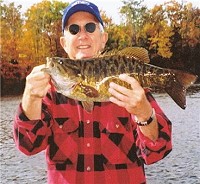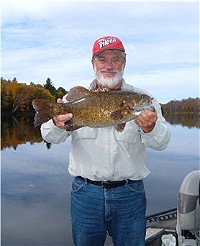 Being a full time guide, I spend at least 170 days per year fishing open water. Through the years, I have spent more time pursuing smallmouth bass than any other species. Like most bronzeback anglers, I feel any day on the water is a good day, but it’s even better when I catch and release a big smallmouth. The more I fish, the more hefty smallmouth have become an obsession.Experience has taught me that to catch big smallmouth, you must fish the right water at the right time. Pre-spawn smallmouth can offer fast action, particularly on clear, natural lakes. Big fish leave deep water and are assessable to anglers. On many lakes, this pre-spawn period is the only time when it’s possible to consistently catch big smallmouth. This pre-spawn period can be unpredictable as changing weather patterns dictate the fishing. It is wise not to put too much pressure on the fishery prior to spawning. Being a full time guide, I spend at least 170 days per year fishing open water. Through the years, I have spent more time pursuing smallmouth bass than any other species. Like most bronzeback anglers, I feel any day on the water is a good day, but it’s even better when I catch and release a big smallmouth. The more I fish, the more hefty smallmouth have become an obsession.Experience has taught me that to catch big smallmouth, you must fish the right water at the right time. Pre-spawn smallmouth can offer fast action, particularly on clear, natural lakes. Big fish leave deep water and are assessable to anglers. On many lakes, this pre-spawn period is the only time when it’s possible to consistently catch big smallmouth. This pre-spawn period can be unpredictable as changing weather patterns dictate the fishing. It is wise not to put too much pressure on the fishery prior to spawning.
Anglers have little trouble finding active river smallmouth in summer, but the big ones can scattered and unpredictable. Putting together a pattern can be difficult. You may do well one day and not find big smallmouth the next. One of the most consistent patterns I have experienced is the behavior of river smallmouth in the fall. Few anglers take advantage of this river action – lakes and reservoirs receive the most pressure at this time of year. In fall, big smallmouth stack up and can be easy to locate if the anglers know what to look for. Once smallmouth have made their fall movement, they remain there for long periods of time. A good river angler can catch big smallmouth on a daily basis as the fish put on the feed before winter.
 Once the water temperature drops into the 50’s, there is a noticeable smallmouth migration in most rivers. This temperature lowering triggers a change in smallmouth forage. In summer, smallmouth are feeding primarily on crayfish. As the water cools, smallmouth become more dependent on minnow-type food. What type of fish becomes the main forage base depends on your geographic location. In my area of northern Wisconsin, river smallmouth primarily feed on river shiners, chubs or perch. Find the preferred forage, and you will find big smallmouth. Once the water temperature drops into the 50’s, there is a noticeable smallmouth migration in most rivers. This temperature lowering triggers a change in smallmouth forage. In summer, smallmouth are feeding primarily on crayfish. As the water cools, smallmouth become more dependent on minnow-type food. What type of fish becomes the main forage base depends on your geographic location. In my area of northern Wisconsin, river smallmouth primarily feed on river shiners, chubs or perch. Find the preferred forage, and you will find big smallmouth.
The edges of creek channels and sloughs can hold the bulk of the remaining forage fish. These baitfish migrate out of the sloughs and creek channels as the water cools. In early spring, they hold tight to weed edges and any available shoreline cover. Later in fall, they hold tight to the main river channel at the base of the slough.
Start fishing the edges of the slough with spinnerbaits. Cast into the slough and bring the spinnerbait over the top of the weeds. Under stable weather conditions, use a tandem spinnerbait, but go to a single blade after a cold front. If you don’t have a strike, let the spinnerbait drop along the river channel. Many times this will trigger a strike from a hawg smallmouth.
After you have caught the active smallmouth with a spinnerbait, move to the upstream edge of the slough and cast deep diving crankbaits tight to the edge of the river channel. Use crankbaits with wide lips that dive quickly. The longer the crankbait stays in the strike zone, the greater your odds to catch fish. When fishing crankbaits, I prefer to use a fiberglass crankbait rod like a Lamiglas XFC 665 or a XFC 705. By using a fiberglass rod, you won’t set the hook too quickly and loose a trophy.
Plastics can also be effective on fall river smallmouth especially when faced with a severe cold front. Fall cold fronts can drop the water temperature and slow down the action. My new tin finesse jigs are very deadly at this time. With tin being 40 percent lighter than lead, the jig has a very slow fall rate that will trigger most neutral or even inactive smallmouth. It is important to work your baits as slow as possible, keeping them tight to the edge of the river channel and any shoreline wood cover. Berkley XT in eight-pound test is ideal for this situation. Super lines are much too visible even in dark water for finesse presentations.
Once the temperature drops below 45 degrees, smallmouth move into their wintering holes. Look in deep water with steep rock drop offs for the largest smallmouth. Since smallmouth will stack up in these holes, use your electronics to mark them. Unlike walleyes, which tend to hold tight to the bottom, smallmouth will suspend off the bottom. On many occasions you will find both species using the same wintering area.
Look for deep holes with a minimal amount of current. In cold water, smallmouth avoid the current as much as possible. Deep holes above dams can be sleeper areas for big fish. The best deep-water area above a dam will be just off the main river channel out of the main current flow. Look in isolated points and downed wood for the largest smallmouth.
The only consistent presentation in this cold water is live bait, although plastics will catch their fair share of fish. Position your boat over the hole either by anchoring or using your electric trolling motor. Vertical jig with the largest shiners available. If vertical jigging fails to produce, let the shiners sit on the bottom. Once you feel a strike, wait a few seconds before setting the hook. If you set the hook too quickly, you will lose both the smallmouth and shiner
One day last November we caught only 6 smallmouth on my favorite hole on the Menominee, but they were all over five pounds. The largest one tipped the scales at 7 pounds! Like I said, any day on the water is a good day, but it’s even better when I catch and release big smallmouth!
Fall river smallmouth will not only supply plenty of fast action, but also give you a shot at a fish of a lifetime. The weather may get nasty, but besides catching trophy fish, you probably will have the river to yourself. Enjoy!
***
Mike Mladenik
Wisconsin Fishing Guide, Author & TV Host
http://www.mikemladenik.com/ |